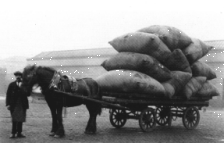Selling the "Clip"
After clipping, the farm sells its "clip". It used to be said, even as recently as the 1990s, that the wool clip should pay the mortgage or the rent of the farm for the year. This is very unlikely to hold true nowadays since the value of wool has dropped and that of land has risen. The main income from sheep is the annual crop of lambs.

Left: Wool being moved from the Great Northern railway yards to the mill in the 1920s.
Each thick hessian "sheet" of wool weighs around 80kg (180lb). The sheets are held together by double ended steel hooks run into the material. There are ten sheets on this wagon, so the load is a little less than a ton, not counting the vehicle itself.
Wool sheets such as these, and newer ones of woven plastic, are still used to hold the wool from Cumbrian farms and are taken to British Wool centres for the clip to be graded and auctioned.
The most local collection centres at Hexham and Carnforth have recently been closed. They were replaced with a new centre at Carlisle.
However, owing to the difficulties of Foot and Mouth Disease, the Carlisle centre was abandoned in 2001 in favour of one at Galashiels in the Scottish Borders. Then problems became apparent in the moving of wool from "F&M infected areas" through "clean areas" and collection was again halted. The remaining 2001 wool clip from west of the M6 motorway was finally moved to Carlisle in January, February and March 2002, while wool from east of the motorway went as usual to Bradford.
The Carlisle centre closed (c. 2009) because sheep numbers were still low and so there was less wool to be handled each autumn.
Wool can now be "dropped off" at various local collection points to be taken to the mills by a local haulier.